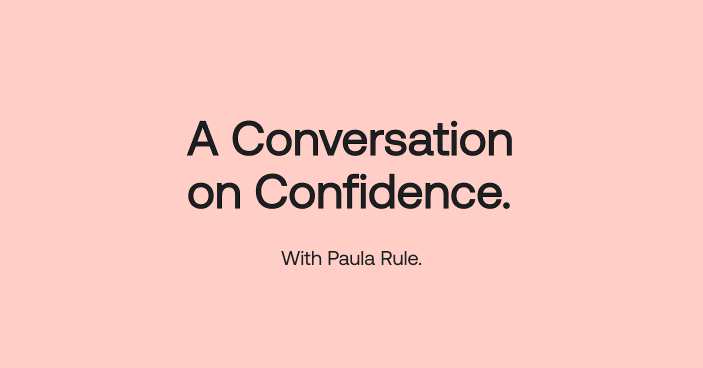A Conversation on Confidence with Paula Rule

At Sweaty Betty, we believe in embracing every version of ourselves—strong, bold, and unapologetically confident. But when the time comes, how often do we find ourselves hesitating to wear the shorts, questioning how we look rather than celebrating how we feel? Enter Paula Rule, confidence coach and founder of The Mental Edge, who is here to remind us that confidence is a skill, not a lucky trait. In this conversation, Paula unpacks the power of self-belief, body positivity, and what we can all learn from high-performing athletes.
Paula knows confidence. As a former high school teacher now working with elite athletes, she has spent years helping people unlock their potential. "I help people navigate their journey to unapologetic and genuine confidence, whether that be in career, sport, or life," she shares. Her mission is clear—helping individuals step into their full power, free from self-doubt and comparison.
Confidence: A Skill You Can Build
What does confidence mean to Paula? "True confidence for me means to acknowledge and bravely step into the best you there is. It's putting your shoulders back, keeping your head high, knowing that you have value and impact, and that the world is better for having you in it."
Yet, one of the biggest misconceptions about confidence is that it comes naturally. "It doesn’t," Paula clarifies. "It’s a learned skill. Some people may have a natural advantage, but for most of us, confidence is built through intentional action. The challenge? It often requires courage, stepping outside our comfort zones. But when we commit to working on it, that’s when the magic happens."
Paula sheds light on why so many women hesitate. "Too many of us believe that we have to look perfect to step out into the world. We worry about the size of our legs or the cellulite that’s made an appearance. Unfortunately, we exist in a comparison culture, and when what we see in the mirror doesn’t align with unrealistic beauty standards, self-doubt creeps in."
Fear of judgment plays a huge role. "We worry about the looks people might give us, reinforcing outdated societal messages about what our bodies ‘should’ look like," she says. "But here’s the truth—our bodies are incredible. They carry us through life, they create life. We are superhuman, and we should wear whatever we like, owning that fact."
Lessons from Elite Athletes on Confidence
Having worked with high-performing athletes, Paula knows a thing or two about unshakable confidence. "Athletes build confidence one step at a time. It starts with self-awareness—being clear on why they do what they do. Too often, athletes link their entire identity to their sport. Instead of ‘Sarah the netballer,’ it should be ‘Sarah who likes to play netball.’ When we understand that we are more than what we do, we gain true confidence."
She also highlights the importance of focusing on the process rather than obsessing over results. "When athletes concentrate on controlling the controllables—effort, mindset, preparation—they lock into their power instead of comparing themselves to others. That’s a lesson we can all apply to our own lives."
What We Can All Learn About Self-Belief
Paula believes that confidence is a practice. "Practice makes progress—not perfect. Let’s get away from the word ‘perfect’ altogether," she urges. "Do the reps. Set time aside to train your brain, evaluate where your beliefs come from, and challenge the narratives that aren’t serving you."
Another key element? Seeking feedback. "When things aren’t going well, dig into the why. When things are going great, dig into the why. Our lives are full of patterns—it’s our job to identify them."
Clothing as a Tool for Confidence
Paula sees clothing as an essential form of self-expression, especially for young people. "Clothing offers a tangible way to communicate identity and belonging. When we put on something that makes us feel good, our whole outlook changes. It doesn’t matter if it’s someone else’s taste—if it makes you feel powerful, wear it."
Paula’s work has shown her that body image concerns impact both men and women, but in different ways. "For many girls, confidence ties into appearance rather than ability. Social conditioning and media influence have shaped that. Boys, on the other hand, tend to tie confidence to function—strength, performance, size. They struggle with feeling ‘not big enough’ or ‘not strong enough,’ often masking insecurity with external bravado."
How Adults Can Reclaim Confidence
Paula encourages adults to take lessons from how we uplift young people and apply them to our own confidence journeys. "We constantly tell young people that growth takes time, yet we hold ourselves to unrealistic standards. Adopting a learning mindset instead of a proving mindset can transform confidence."
Reframing setbacks is another crucial skill. "We teach kids that failure is feedback, yet we don’t do the same for ourselves. Instead of self-criticism, approach challenges with curiosity. What can you learn? How can you grow?"
Finally, surround yourself with the right support. "Just as we encourage young people to find positive influences, adults thrive when they create environments that reinforce confidence rather than chip away at it. And above all, be kinder to yourself. We are great at supporting others, highlighting their strengths—let’s start doing the same for ourselves."
The Bottom Line? Wear the Damn Shorts
Confidence isn’t about waiting until you feel ‘ready.’ It’s about making the choice to show up as you are, imperfections and all. "Wear the damn shorts," Paula says. "Own your body, your story, your power. You don’t need permission to take up space, you already belong."
So let’s take a page from Paula’s book, step out of our comfort zones, challenge the narratives that hold us back, and, most importantly, wear the damn shorts.


